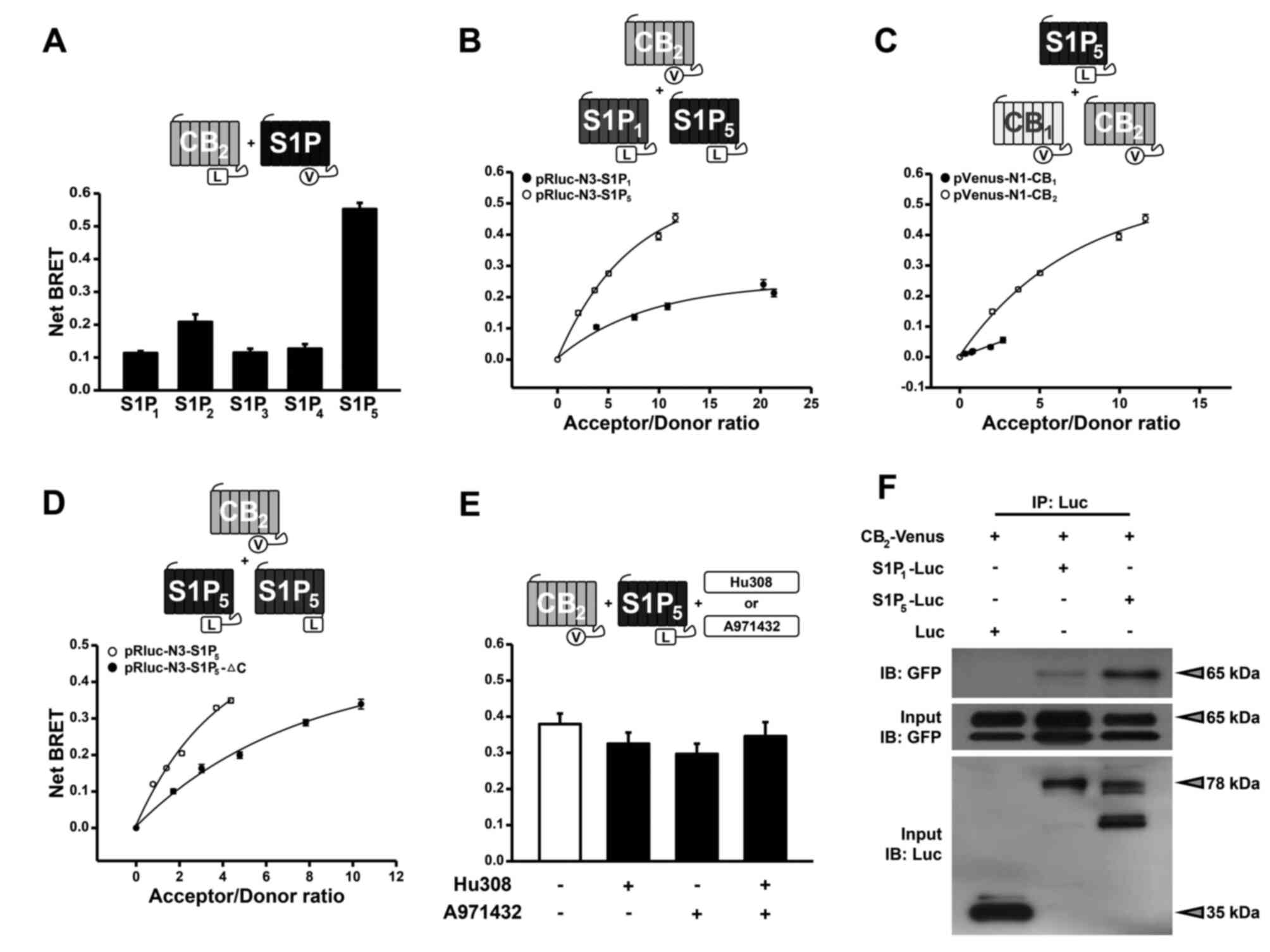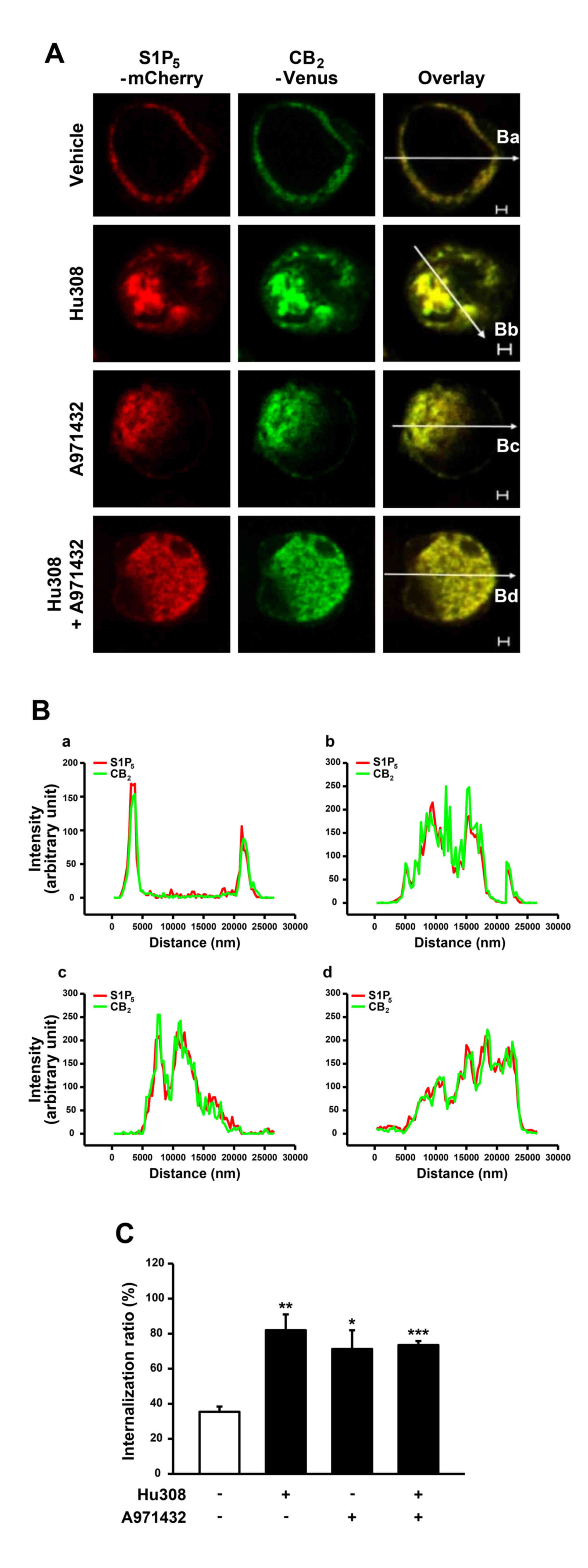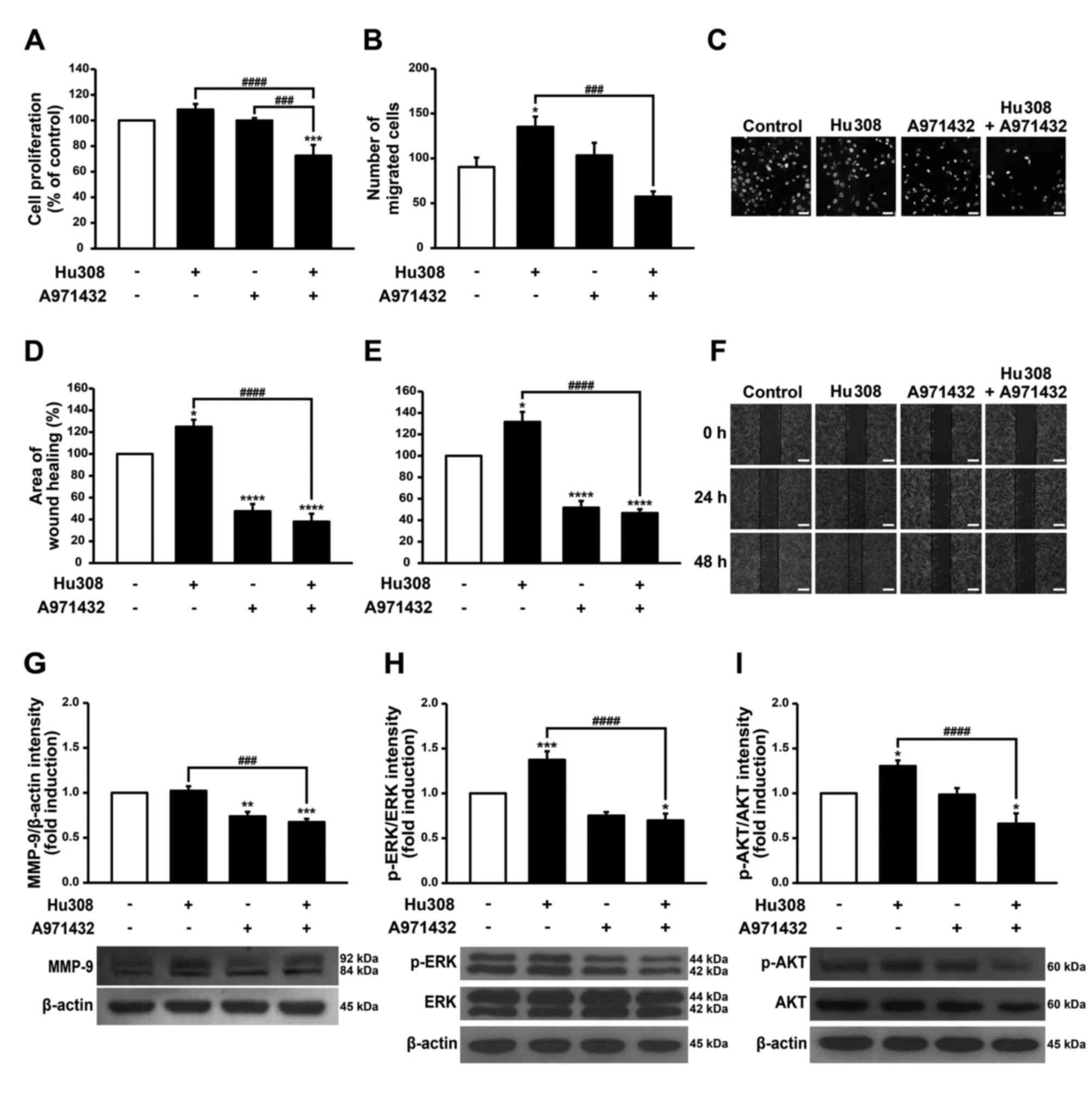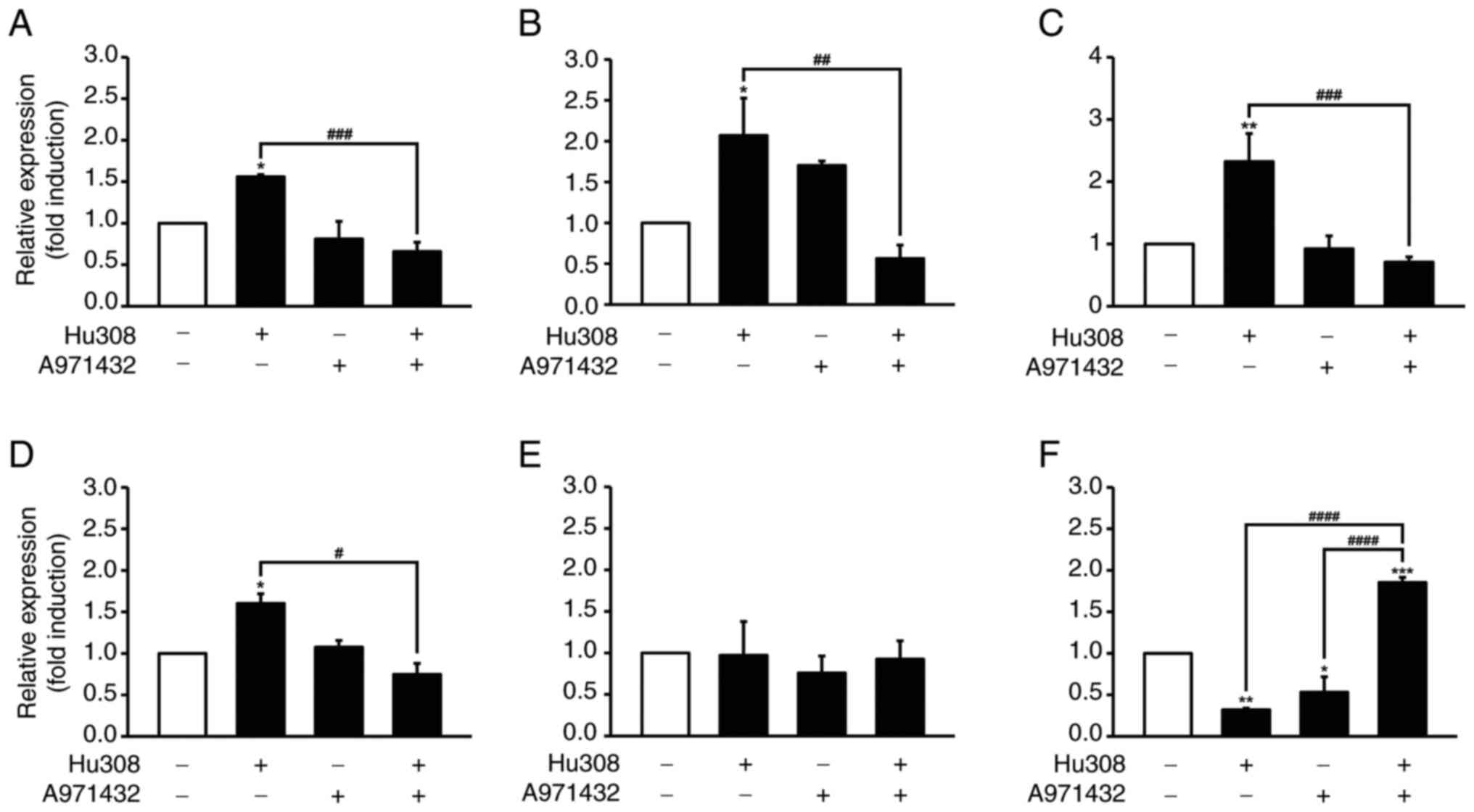Negative regulation of cannabinoid receptor 2‑induced tumorigenic effect by sphingosine‑1‑phosphate receptor 5 activation
- Authors:
- Yuna Kim
- Sungho Ghil
-
Affiliations: Department of Life Science, Kyonggi University, Suwon, Gyeonggi 16227, Republic of Korea - Published online on: February 6, 2025 https://doi.org/10.3892/or.2025.8874
- Article Number: 41
This article is mentioned in:
Abstract
 |
 |
 |
 |
|
Duc NM, Kim HR and Chung KY: Structural mechanism of G protein activation by G protein-coupled receptor. Eur J Pharmacol. 763:214–222. 2015. View Article : Google Scholar : PubMed/NCBI | |
|
Duc NM, Kim HR and Chung KY: Recent progress in understanding the conformational mechanism of heterotrimeric G protein activation. Biomol Ther (Seoul). 25:4–11. 2017. View Article : Google Scholar : PubMed/NCBI | |
|
Byrne KF, Pal A, Curtin JF, Stephens JC and Kinsella GK: G-protein-coupled receptors as therapeutic targets for glioblastoma. Drug Discov Today. 26:2858–2870. 2021. View Article : Google Scholar : PubMed/NCBI | |
|
Hosami F, Ghadimkhah MH, Salimi V, Ghorbanhosseini SS and Tavakoli-Yaraki M: The strengths and limits of cannabinoids and their receptors in cancer: Insights into the role of tumorigenesis-underlying mechanisms and therapeutic aspects. Biomed Pharmacother. 144:1122792021. View Article : Google Scholar : PubMed/NCBI | |
|
Pérez-Gómez E, Andradas C, Blasco-Benito S, Caffarel MM, García-Taboada E, Villa-Morales M, Moreno E, Hamann S, Martín-Villar E, Flores JM, et al: Role of cannabinoid receptor CB2 in HER2 pro-oncogenic signaling in breast cancer. J Natl Cancer Inst. 107:djv0772015. View Article : Google Scholar : PubMed/NCBI | |
|
Blasco-Benito S, Moreno E, Seijo-Vila M, Tundidor I, Andradas C, Caffarel MM, Caro-Villalobos M, Urigüen L, Diez-Alarcia R, Moreno-Bueno G, et al: Therapeutic targeting of HER2-CB2R heteromers in HER2-positive breast cancer. Proc Natl Acad Sci USA. 116:3863–3872. 2019. View Article : Google Scholar : PubMed/NCBI | |
|
Olianas MC, Dedoni S and Onali P: Cannabinoid CB1 and CB2 receptors differentially regulate TNF-α-induced apoptosis and LPA1-mediated pro-survival signaling in HT22 hippocampal cells. Life Sci. 276:1194072021. View Article : Google Scholar : PubMed/NCBI | |
|
Martínez-Martínez E, Martín-Ruiz A, Martín P, Calvo V, Provencio M and Garcia JM: CB2 cannabinoid receptor activation promotes colon cancer progression via AKT/GSK3β signaling pathway. Oncotarget. 7:68781–68791. 2016. View Article : Google Scholar : PubMed/NCBI | |
|
Pulli I, Asghar MY, Kemppainen K and Törnquist K: Sphingolipid-mediated calcium signaling and its pathological effects. Biochim Biophys Acta Mol Cell Res. 1865:1668–1677. 2018. View Article : Google Scholar : PubMed/NCBI | |
|
Lyapina E, Marin E, Gusach A, Orekhov P, Gerasimov A, Luginina A, Vakhrameev D, Ergasheva M, Kovaleva M, Khusainov G, et al: Structural basis for receptor selectivity and inverse agonism in S1P5 receptors. Nat Commun. 13:47362022. View Article : Google Scholar : PubMed/NCBI | |
|
Wang P, Yuan Y, Lin W, Zhong H, Xu K and Qi X: Roles of sphingosine-1-phosphate signaling in cancer. Cancer Cell Int. 19:2952019. View Article : Google Scholar : PubMed/NCBI | |
|
van Doorn R, Lopes Pinheiro MA, Kooij G, Lakeman K, van het Hof B, van der Pol SM, Geerts D, van Horssen J, van der Valk P, van der Kam E, et al: Sphingosine 1-phosphate receptor 5 mediates the immune quiescence of the human brain endothelial barrier. J Neuroinflammation. 9:1332012. View Article : Google Scholar : PubMed/NCBI | |
|
Hu WM, Li L, Jing BQ, Zhao YS, Wang CL, Feng L and Xie YE: Effect of S1P5 on proliferation and migration of human esophageal cancer cells. World J Gastroenterol. 16:1859–1866. 2010. View Article : Google Scholar : PubMed/NCBI | |
|
Bien-Möller S, Lange S, Holm T, Böhm A, Paland H, Küpper J, Herzog S, Weitmann K, Havemann C, Vogelgesang S, et al: Expression of S1P metabolizing enzymes and receptors correlate with survival time and regulate cell migration in glioblastoma multiforme. Oncotarget. 7:13031–13046. 2016. View Article : Google Scholar : PubMed/NCBI | |
|
Mohamud Yusuf A, Zhang X, Gulbins E, Peng Y, Hagemann N and Hermann DM: Signaling roles of sphingolipids in the ischemic brain and their potential utility as therapeutic targets. Neurobiol Dis. 201:1066822024. View Article : Google Scholar : PubMed/NCBI | |
|
Hauser AS, Attwood MM, Rask-Andersen M, Schiöth HB and Gloriam DE: Trends in GPCR drug discovery: New agents, targets and indications. Nat Rev Drug Discov. 16:829–842. 2017. View Article : Google Scholar : PubMed/NCBI | |
|
Hopkins MM, Liu Z and Meier KE: Positive and negative cross-talk between lysophosphatidic acid receptor 1, free fatty acid receptor 4, and epidermal growth factor receptor in human prostate cancer cells. J Pharmacol Exp Ther. 359:124–133. 2016. View Article : Google Scholar : PubMed/NCBI | |
|
Farooq Z, Howell LA and McCormick PJ: Probing GPCR dimerization using peptides. Front Endocrinol (Lausanne). 13:8437702022. View Article : Google Scholar : PubMed/NCBI | |
|
Bouvier M: Oligomerization of G-protein-coupled transmitter receptors. Nat Rev Neurosci. 2:274–286. 2001. View Article : Google Scholar : PubMed/NCBI | |
|
Faron-Górecka A, Szlachta M, Kolasa M, Solich J, Górecki A, Kuśmider M, Żurawek D and Dziedzicka-Wasylewska M: Understanding GPCR dimerization. Methods Cell Biol. 149:155–178. 2019. View Article : Google Scholar : PubMed/NCBI | |
|
Caffarel MM, Sarrió D, Palacios J, Guzmán M and Sánchez C: Delta9-tetrahydrocannabinol inhibits cell cycle progression in human breast cancer cells through Cdc2 regulation. Cancer Res. 66:6615–6621. 2006. View Article : Google Scholar : PubMed/NCBI | |
|
Song E and Ghil S: Crosstalk between cannabinoid receptor 2 and lysophosphatidic acid receptor 5. Biochem Biophys Res Commun. 666:154–161. 2023. View Article : Google Scholar : PubMed/NCBI | |
|
Livak KJ and Schmittgen TD: Analysis of relative gene expression data using real-time quantitative PCR and the 2(−Delta Delta C(T)) method. Methods. 25:402–408. 2001. View Article : Google Scholar : PubMed/NCBI | |
|
Besson B, Eun H, Kim S, Windisch MP, Bourhy H and Grailhe R: Optimization of BRET saturation assays for robust and sensitive cytosolic protein-protein interaction studies. Sci Rep. 12:99872022. View Article : Google Scholar : PubMed/NCBI | |
|
Somvanshi RK and Kumar U: Pathophysiology of GPCR homo- and heterodimerization: Special emphasis on somatostatin receptors. Pharmaceuticals (Basel). 5:417–446. 2012. View Article : Google Scholar : PubMed/NCBI | |
|
Lamberts JT and Traynor JR: Opioid receptor interacting proteins and the control of opioid signaling. Curr Pharm Des. 19:7333–7347. 2013. View Article : Google Scholar : PubMed/NCBI | |
|
Liu H and Wang L: MicroRNA-34a negatively regulates Netrin1 and mediates MEK/ERK pathway to regulate chemosensitivity of gastric cancer cells. Discov Oncol. 15:5632024. View Article : Google Scholar : PubMed/NCBI | |
|
Song Q, Zhang W, Shi D, Zhang Z, Zhao Q, Wang M, Huang M, Meng J, Cui W and Luo X: Overexpression of cannabinoid receptor 2 is associated with human breast cancer proliferation, apoptosis, chemosensitivity and prognosis via the PI3K/Akt/mTOR signaling pathway. Cancer Med. 12:13538–13550. 2023. View Article : Google Scholar : PubMed/NCBI | |
|
Galve-Roperh I, Sánchez C, Cortés ML, Gómez del Pulgar T, Izquierdo M and Guzmán M: Anti-tumoral action of cannabinoids: Involvement of sustained ceramide accumulation and extracellular signal-regulated kinase activation. Nat Med. 6:313–319. 2000. View Article : Google Scholar : PubMed/NCBI | |
|
Lorente M, Torres S, Salazar M, Carracedo A, Hernández-Tiedra S, Rodríguez-Fornés F, García-Taboada E, Meléndez B, Mollejo M, Campos-Martín Y, et al: Stimulation of the midkine/ALK axis renders glioma cells resistant to cannabinoid antitumoral action. Cell Death Differ. 18:959–973. 2011. View Article : Google Scholar : PubMed/NCBI | |
|
Calatozzolo C, Salmaggi A, Pollo B, Sciacca FL, Lorenzetti M, Franzini A, Boiardi A, Broggi G and Marras C: Expression of cannabinoid receptors and neurotrophins in human gliomas. Neurol Sci. 28:304–310. 2007. View Article : Google Scholar : PubMed/NCBI | |
|
Hashemi M, Bashi S and Zali A: The expression level of cannabinoid receptors type 1 and 2 in the different types of astrocytomas. Mol Biol Rep. 47:5461–5467. 2020. View Article : Google Scholar : PubMed/NCBI | |
|
Wang F, Wang J, Zhao T, Zhang Y and Li Q: CB2 receptor agonist JWH133 activates AMPK to inhibit growth of C6 glioma cells. Open Life Sci. 14:363–375. 2019. View Article : Google Scholar : PubMed/NCBI | |
|
Sánchez C, de Ceballos ML, Gomez del Pulgar T, Rueda D, Corbacho C, Velasco G, Galve-Roperh I, Huffman JW, Ramón y Cajal S and Guzmán M: Inhibition of glioma growth in vivo by selective activation of the CB(2) cannabinoid receptor. Cancer Res. 61:5784–5789. 2001.PubMed/NCBI | |
|
Buchalska B, Kamińska K, Owe-Larsson M and Cudnoch-Jędrzejewska A: Cannabinoids in the treatment of glioblastoma. Pharmacol Rep. 76:223–234. 2024. View Article : Google Scholar : PubMed/NCBI | |
|
Massi P, Vaccani A, Ceruti S, Colombo A, Abbracchio MP and Parolaro D: Antitumor effects of cannabidiol, a nonpsychoactive cannabinoid, on human glioma cell lines. J Pharmacol Exp Ther. 308:838–845. 2004. View Article : Google Scholar : PubMed/NCBI | |
|
Van Brocklyn JR, Young N and Roof R: Sphingosine-1-phosphate stimulates motility and invasiveness of human glioblastoma multiforme cells. Cancer Lett. 199:53–60. 2003. View Article : Google Scholar : PubMed/NCBI | |
|
Yoshida Y, Nakada M, Sugimoto N, Harada T, Hayashi Y, Kita D, Uchiyama N, Hayashi Y, Yachie A, Takuwa Y and Hamada J: Sphingosine-1-phosphate receptor type 1 regulates glioma cell proliferation and correlates with patient survival. Int J Cancer. 126:2341–2352. 2010. View Article : Google Scholar : PubMed/NCBI | |
|
Young N and Van Brocklyn JR: Roles of sphingosine-1-phosphate (S1P) receptors in malignant behavior of glioma cells. Differential effects of S1P2 on cell migration and invasiveness. Exp Cell Res. 313:1615–1627. 2007. View Article : Google Scholar : PubMed/NCBI | |
|
Lepley D, Paik JH, Hla T and Ferrer F: The G protein-coupled receptor S1P2 regulates Rho/Rho kinase pathway to inhibit tumor cell migration. Cancer Res. 65:3788–3795. 2005. View Article : Google Scholar : PubMed/NCBI | |
|
Malchinkhuu E, Sato K, Maehama T, Mogi C, Tomura H, Ishiuchi S, Yoshimoto Y, Kurose H and Okajima F: S1P(2) receptors mediate inhibition of glioma cell migration through Rho signaling pathways independent of PTEN. Biochem Biophys Res Commun. 366:963–968. 2008. View Article : Google Scholar : PubMed/NCBI | |
|
Aguado T, Carracedo A, Julien B, Velasco G, Milman G, Mechoulam R, Alvarez L, Guzmán M and Galve-Roperh I: Cannabinoids induce glioma stem-like cell differentiation and inhibit gliomagenesis. J Biol Chem. 282:6854–6862. 2007. View Article : Google Scholar : PubMed/NCBI | |
|
Treppiedi D, Marra G, Di Muro G, Catalano R, Mangili F, Esposito E, Calebiro D, Arosio M, Peverelli E and Mantovani G: Dimerization of GPCRs: Novel insight into the role of FLNA and SSAs regulating SST2 and SST5 homo- and hetero-dimer formation. Front Endocrinol (Lausanne). 13:8926682022. View Article : Google Scholar : PubMed/NCBI | |
|
Sayers NS, Anujan P, Yu HN, Palmer SS, Nautiyal J, Franks S and Hanyaloglu AC: Follicle-stimulating hormone induces lipid droplets via Gαi/o and β-arrestin in an endometrial cancer cell line. Front Endocrinol (Lausanne). 12:7988662022. View Article : Google Scholar : PubMed/NCBI | |
|
Coke CJ, Scarlett KA, Chetram MA, Jones KJ, Sandifer BJ, Davis AS, Marcus AI and Hinton CV: Simultaneous activation of induced heterodimerization between CXCR4 chemokine receptor and cannabinoid receptor 2 (CB2) Reveals a mechanism for regulation of tumor progression. J Biol Chem. 291:9991–10005. 2016. View Article : Google Scholar : PubMed/NCBI | |
|
Scarlett KA, White EZ, Coke CJ, Carter JR, Bryant LK and Hinton CV: Agonist-induced CXCR4 and CB2 heterodimerization inhibits Gα13/RhoA-mediated migration. Mol Cancer Res. 16:728–739. 2018. View Article : Google Scholar : PubMed/NCBI | |
|
Hong H, Yoon B and Ghil S: Interactions between lysophosphatidylinositol receptor GPR55 and sphingosine-1-phosphate receptor S1P5 in live cells. Biochem Biophys Res Commun. 570:53–59. 2021. View Article : Google Scholar : PubMed/NCBI | |
|
Bang G and Ghil S: BRET analysis reveals interaction between the lysophosphatidic acid receptor LPA2 and the lysophosphatidylinositol receptor GPR55 in live cells. FEBS Lett. 595:1806–1818. 2021. View Article : Google Scholar : PubMed/NCBI | |
|
Mala U, Baral TK and Somasundaram K: Integrative analysis of cell adhesion molecules in glioblastoma identified prostaglandin F2 receptor inhibitor (PTGFRN) as an essential gene. BMC Cancer. 22:6422022. View Article : Google Scholar : PubMed/NCBI | |
|
Han Y and Wang H: MiR-3918 inhibits tumorigenesis of glioma via targeting EGFR to REGULATE PI3K/AKT and ERK pathways. J Mol Neurosci. 72:433–440. 2022. View Article : Google Scholar : PubMed/NCBI | |
|
Jiang J, Lu J, Wang X, Sun B, Liu X, Ding Y and Gao G: Glioma stem cell-derived exosomal miR-944 reduces glioma growth and angiogenesis by inhibiting AKT/ERK signaling. Aging (Albany NY). 13:19243–19259. 2021. View Article : Google Scholar : PubMed/NCBI | |
|
Lou F, Abramyan TM, Jia H, Tropsha A and Jones AM: An atypical heterotrimeric Gα protein has substantially reduced nucleotide binding but retains nucleotide-independent interactions with its cognate RGS protein and Gβγ dimer. J Biomol Struct Dyn. 38:5204–5218. 2020. View Article : Google Scholar : PubMed/NCBI | |
|
Furcht CM, Buonato JM, Skuli N, Mathew LK, Muñoz Rojas AR, Simon MC and Lazzara MJ: Multivariate signaling regulation by SHP2 differentially controls proliferation and therapeutic response in glioma cells. J Cell Sci. 127:3555–3567. 2014.PubMed/NCBI | |
|
Daniele S, Costa B, Zappelli E, Da Pozzo E, Sestito S, Nesi G, Campiglia P, Marinelli L, Novellino E, Rapposelli S and Martini C: Combined inhibition of AKT/mTOR and MDM2 enhances glioblastoma multiforme cell apoptosis and differentiation of cancer stem cells. Sci Rep. 5:99562015. View Article : Google Scholar : PubMed/NCBI | |
|
Fuxe K, Marcellino D, Borroto-Escuela DO, Guescini M, Fernández-Dueñas V, Tanganelli S, Rivera A, Ciruela F and Agnati LF: Adenosine-dopamine interactions in the pathophysiology and treatment of CNS disorders. CNS Neurosci Ther. 16:e18–e42. 2010. View Article : Google Scholar : PubMed/NCBI | |
|
Guzmán-Hernández ML, Vázquez-Macías A, Carretero-Ortega J, Hernández-García R, García-Regalado A, Hernández-Negrete I, Reyes-Cruz G, Gutkind JS and Vázquez-Prado J: Differential inhibitor of Gbetagamma signaling to AKT and ERK derived from phosducin-like protein: Effect on sphingosine 1-phosphate-induced endothelial cell migration and in vitro angiogenesis. J Biol Chem. 284:18334–18346. 2009. View Article : Google Scholar : PubMed/NCBI | |
|
Zhang XH, Shen CL, Wang XY, Xiong WF, Shang X, Tang LY, Zhang HX, Wan YH, Wu YB, Fei J, et al: Increased anxiety-like behaviors in Adgra1−/− male but not female mice are attributable to elevated neuron dendrite density, upregulated PSD95 expression, and abnormal activation of the PI3K/AKT/GSK-3β and MEK/ERK pathways. Neuroscience. 503:131–145. 2022. View Article : Google Scholar : PubMed/NCBI | |
|
Saotome Y, Winter CG and Hirsh D: A widely expressed novel C2H2 zinc-finger protein with multiple consensus phosphorylation sites is conserved in mouse and man. Gene. 152:233–238. 1995. View Article : Google Scholar : PubMed/NCBI | |
|
Zhang Z, Zhong L, Dan W, Chu X, Liu C, Luo X, Wan P, Liu Z, Lu Y, Wang X and Liu B: ZFP91 promotes cell proliferation and inhibits cell apoptosis in AML via inhibiting the proteasome-dependent degradation of RIP1. Int J Med Sci. 19:274–285. 2022. View Article : Google Scholar : PubMed/NCBI | |
|
Yang J, Jin W, Zhang X, Chang P and Zheng D: Breviscapine participates in the progression of prostate cancer by inhibiting ZFP91 expression through upregulation of MicroRNA-129-5p. Evid Based Complement Alternat Med. 2021:15116072021. View Article : Google Scholar : PubMed/NCBI | |
|
Tang N, Xu S, Song T, Qiu Y, He J and Fu X: Zinc finger protein 91 accelerates tumour progression by activating β-catenin signalling in pancreatic cancer. Cell Prolif. 54:e130312021. View Article : Google Scholar : PubMed/NCBI | |
|
Qiu GZ, Mao XY, Ma Y, Gao XC, Wang Z, Jin MZ, Sun W, Zou YX, Lin J, Fu HL and Jin WL: Ubiquitin-specific protease 22 acts as an oncoprotein to maintain glioma malignancy through deubiquitinating B cell-specific Moloney murine leukemia virus integration site 1 for stabilization. Cancer Sci. 109:2199–2210. 2018. View Article : Google Scholar : PubMed/NCBI | |
|
Ma S, Pang C, Song L, Guo F and Sun H: Activating transcription factor 3 is overexpressed in human glioma and its knockdown in glioblastoma cells causes growth inhibition both in vitro and in vivo. Int J Mol Med. 35:1561–1573. 2015. View Article : Google Scholar : PubMed/NCBI | |
|
Pan Z, Chen C, Huang X, Xiong Y, Kang X, Zhou J, Guo X, Zheng S, Wang C, Zheng F and Hu W: Migration-inducing gene-7 promotes glioma cell proliferation and invasiveness via activating the MAPK signaling pathway. Neoplasma. 70:534–544. 2023. View Article : Google Scholar : PubMed/NCBI | |
|
Wong BS, Shah SR, Yankaskas CL, Bajpai VK, Wu PH, Chin D, Ifemembi B, ReFaey K, Schiapparelli P, Zheng X, et al: A microfluidic cell-migration assay for the prediction of progression-free survival and recurrence time of patients with glioblastoma. Nat Biomed Eng. 5:26–40. 2021. View Article : Google Scholar : PubMed/NCBI | |
|
Zhang Q, Zheng J, Wu W, Lian H, Iranzad N, Wang E, Yang L, Wang X and Jiang X: TRIM56 acts through the IQGAP1-CDC42 signaling axis to promote glioma cell migration and invasion. Cell Death Dis. 14:1782023. View Article : Google Scholar : PubMed/NCBI | |
|
Ivanenko KA, Prassolov VS and Khabusheva ER: Transcription factor Sp1 in the expression of genes encoding components of MAPK, JAK/STAT, and PI3K/Akt signaling pathways. Mol Biol (Mosk). 56:832–847. 2022.(In Russian). View Article : Google Scholar : PubMed/NCBI | |
|
Hu J, Sun F, Chen W, Zhang J, Zhang T, Qi M, Feng T, Liu H, Li X, Xing Y, et al: BTF3 sustains cancer stem-like phenotype of prostate cancer via stabilization of BMI1. J Exp Clin Cancer Res. 38:2272019. View Article : Google Scholar : PubMed/NCBI | |
|
Wang H, Xing J, Wang W, Lv G, He H, Lu Y, Sun M, Chen H and Li X: Molecular characterization of the oncogene BTF3 and Its targets in colorectal cancer. Front Cell Dev Biol. 8:6015022021. View Article : Google Scholar : PubMed/NCBI | |
|
Wang H, Gao L, Qi M, Su P, Xiong X, Zhao J, Hu J and Han B: BTF3 promotes stemness and inhibits Type I Interferon signaling pathway in triple-negative breast cancer. Biochem Biophys Res Commun. 537:22–28. 2021. View Article : Google Scholar : PubMed/NCBI | |
|
Carvalho A, Viaene J, Vandenbussche G, De Braekeleer K, Masereel B, Wouters J, Souard F, Vander Heyden Y, Van Antwerpen P, Delporte C and Mathieu V: A new potential anti-cancer beta-carboline derivative decreases the expression levels of key proteins involved in glioma aggressiveness: A proteomic investigation. Drug Dev Res. 81:32–42. 2020. View Article : Google Scholar : PubMed/NCBI | |
|
Vahedi MM, Shahini A, Mottahedi M, Garousi S, Shariat Razavi SA, Pouyamanesh G, Afshari AR, Ferns GA and Bahrami A: Harmaline exerts potentially anti-cancer effects on U-87 human malignant glioblastoma cells in vitro. Mol Biol Rep. 50:4357–4366. 2023. View Article : Google Scholar : PubMed/NCBI | |
|
Lunn CA, Reich EP, Fine JS, Lavey B, Kozlowski JA, Hipkin RW, Lundell DJ and Bober L: Biology and therapeutic potential of cannabinoid CB2 receptor inverse agonists. Br J Pharmacol. 153:226–239. 2008. View Article : Google Scholar : PubMed/NCBI | |
|
Whiting ZM, Yin J, de la Harpe SM, Vernall AJ and Grimsey NL: Developing the cannabinoid receptor 2 (CB2) pharmacopoeia: past, present, and future. Trends Pharmacol Sci. 43:754–771. 2022. View Article : Google Scholar : PubMed/NCBI |










